All metals are chemical elements that conduct heat and electricity. Their densely packed crystal structure causes them to be heavy, malleable, ductile strong, opaque, and shiny. Non-noble metals, for jewelry purposes, are those metals that are not platinum, gold, or silver (this list may differ from the lists used by chemists). In fine jewelry, non-noble metals such as nickel, zinc, aluminum, and copper, are more commonly found in alloys, though don’t rule out finding steel and other non-noble metals used in fine jewelry too. In fashion or costume jewelry, non-noble metals abound.
Elemental Metals
Aluminum
Aluminum is an abundant white base metal of low density. It was first introduced at the Paris exhibition of 1855 but historically, it was used only infrequently for jewelry. Contemporary jewelry artisans now use aluminum because it is light and it can be anodized to create a wide variety of colors. Often found in contemporary chain mail jewelry.
Antimony
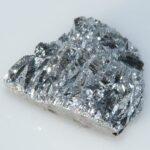
Antimony is a chemical element on the Periodic Table with the atomic number 51 and symbol Sb. This brittle, white element is used in the production of pewter. When alloyed with lead it is used in lead acid batteries. Lead-free solder can contain antimony. Antimony has been used since antiquity when a “lost art” technique rendered it malleable enough for use.
Copper
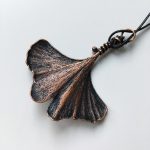
Copper is a naturally occurring metallic element with a brownish-red color. It has been used since ancient times to create jewelry both in its pure form and as an ingredient, in varying amounts, in several metal alloys.
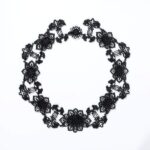
Iron
Iron is a ferrous metallic element that was sometimes used in the past to make jewelry. Celtic Jewelry and Anglo-Saxon jewelry in the form of buckles are some surviving examples.
Lead
Lead is an element, atomic number 82, symbol Pb. It is quite soft, ductile, malleable and very dense. In the past lead was alloyed with other metals to make them heavier, more ductile and more malleable. Lead has little use in jewelry today but was once widely used in solder for jewelry repair. It was a popular way to repair delicate jewelry items because of the low temperature required for it to melt. These lead spots can be observed on the reverse of antique jewelry and are usually black or dark gray and lumpy.
Historically, lead was alloyed with tin to make pewter; lead-free pewters are now available. Enamels contain lead even today and some artisans prefer to use leaded enamel even though lead-free enamel is available.
Because of the poisonous and toxic nature of lead, it is highly regulated and not recommended for use in jewelry.
Niobium
Niobium is a chemical element. Its symbol on the Periodic Table of the Elements is Nb and its atomic number is 41. Niobium is a soft grey metal that is often used in alloys and sometimes used in eyeglasses and jewelry because of its low toxicity (and therefore low rate of allergic reactions) and its ability to be anodized producing a virtual rainbow of colors.
Tin
Tin is a chemical element atomic number 50, symbol Sn. Once extracted from its base compound, usually cassiterite, it is a very easily worked, very soft metal that does not oxidize. Tin is often used to plate steel because of its corrosion resistance. Jewelers usually encounter tin in solder, pewter, and bronze.
Titanium
Titanium is a low density, silver color chemical element (Ti). Alloys of titanium are very strong in contrast to their light weight and relatively corrosion resistant compared to other alloys. This makes them ideal for aerospace, automotive, medical and other industries. Jewelry uses include wedding bands, findings, jump rings, wire and more.
Zinc
Zinc is a metallic chemical element. Physically it is a bluish-white brittle metal used mainly in alloying other metals. It is used in karat gold (less than 14%), brass and solder.
Alloys
Alpaca
Alpaca (or alpacca) is an alloy of 65% copper, 19% zinc, 14% nickel and 2% silver. Alpaca, used as a base metal and heavily plated with silver, is found in jewelry, flatware and holloware.
- Alternative names: neusilber, argentan, argentor, bendorfer silver, christoffel metal, packfung, peru silver, sterling metal, nickel silver, German silver, white metal.
Britannia Metal
Britannia metal is a lead-free alloy of pewter developed in England in the 18th century. It polishes more easily than traditional pewter and tarnishes less. The chemical composition is tin (91%), copper (2%) and antimony (7%).
This should not be confused with the “Britannia silver” standard.
Bronze
Bronze is an alloy of copper and tin. It can be plated with gold, etched, fabricated and soldered. Bronze is found in fashion jewelry, often with a precious metal plating.
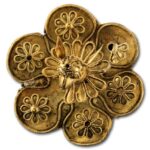
Electrum
Electrum is a naturally occurring alloy consisting mainly of gold and silver but may contain trace elements of other metals like platinum or copper. It was used in ancient jewelry and in the first coins made by man.
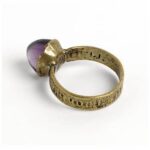
Latten
Latten is a copper alloy that was used extensively throughout the Middle Ages into the late 18th century. It was used to craft decorative details on metalwork, fabricate flatware and livery and as an inexpensive material in the production of finger rings, particularly the widely worn signet ring.
Niello
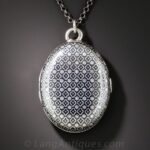
Niello (from Latin: Nigellus = “blackened”) is a metallic alloy with sulfur which is used as a surface decoration technique which, much like enamel, is fused to a metal base. The luster of niello, however, is metallic instead of vitreous and it is much tougher than enamel. Niello comes in just one color – black of various tones – which contrasts highly with silver, the most popular base for niello work. Read More
Osmior
Osmior (or plator, or platinor) was a white replacement metal for platinum (around 1918). It is also a watch brand.
Pewter
Pewter is an alloy of tin, lead, antimony and copper. Traditionally it was used for utensils and dishes, and sometimes jewelry. In 1769 pewter became an alloy of tin, antimony and copper, sometimes referred to as Britannia metal. Today you often see aluminum based alloys simulating pewter because of the rising cost of tin.
Pinchbeck
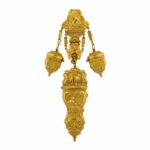
Pinchbeck is an alloy of copper and zinc (approximately 17% zinc and 83% copper) invented circa 1720 by Christopher Pinchbeck. It looked like gold but was much lighter which made it very popular for chatelaines, buckles, snuff boxes and watch cases. In addition, pinchbeck was used extensively in the manufacture of costume jewelry. One major benefit is that it stayed unoxidized for a fairly long time retaining a shiny gold appearance. Pinchbeck was eventually replaced by rolled gold and 9K gold.
Steel
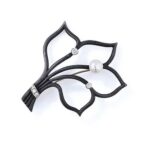
Steel is a metal alloy of iron and a small amount of carbon (2.1% or less). The carbon, or other elements, acts as a hardening agent. The steel alloy has been known since before the Renaissance but was difficult to produce in quantity. With the invention of the “Bessemer Process” of steel production, which removes impurities from the iron by oxidation, it became cheaper and easier to produce steel in volume. Today steel is one of the most common manufacturing and building materials in the world.
Other Metal Terms
Argentan
Argentan is a French word stamped onto objects that look like silver but are not silver.
Examples: Nickel and German-silver or alpaca.
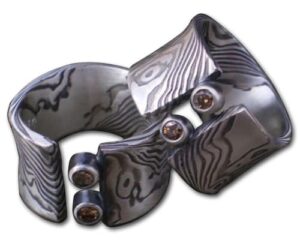
Mokume Gane
Mokume Gane is a lamination of metal that results in a woodgrain effect on the surface. All the metals to be laminated must be similar in melting point and malleability. Copper is almost always used for its malleability. This process was first used in Japan 300 years ago in sword making.
Ormolu
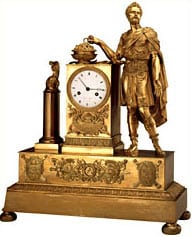
Ormolu is a French word that means “ground gold.” Gold leaf or metal ground for gilding another metal and a metal that has been gilded are both uses for the term. It is also used to describe an alloy composed of copper, tin and zinc that has the color of gold and is used for small clock cases and ornaments for wooded clocks, sometimes lightly gilded with gold. In current usage, ormolu is a term loosely used to describe brass or bronze gilded by fire gilding or mercury gilding. This has been done in England as mounts for porcelain or glass objects.
Quincaille
Quincaille is a French term for jewelry made from steel.
Plating & Bonding
Plating usually involves coating an inexpensive or base metal with a noble metal. This can be done by the process of electroplating – covering metal articles with a film of another metal or by bonding a sheet of metal to a base metal as with rolled gold plate.
E.P.B.M.
E.P.B.M. is the abbreviation for “electroplate on Britannia metal.”
E.P.C.
E.P.C. is the abbreviation for “electroplate on copper.”
E.P.N.S.
E.P.N.S. is the abbreviation for “electroplate on nickel silver.”
Solder
Solder is a metal alloy specifically formulated for use in soldering (a process that joins two pieces of metal by using solder and melting it between them to form a bond.)There are different alloys for different melting points. Soft solders melt at a low heat and usually contain lead, tin or bismuth. Hard solders are alloys of gold, silver or brass and melt when the work is red hot.
